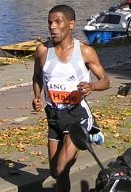Being a runner for the past 30+ years and treating runners for the past 20+ years, I’ve studied running biomechanics from both angles; both to improve my running and to figure it out for my clients. And, I’ve found some interesting things.
What I found was that stride frequency is the same for olympic level distance runners and for local fast guys. What I mean is that if you’ve been a local fast guy or gal, you can count the number of times your left foot hits the ground each minute and you’ll see that it is about 90 to 95 beats a minute. Well if you count the number of times the left foot hits the ground of the fastest men and women in the world, the olympic level runners you’ll see that they also have a frequency of 90 to 95 beats a minute. And this frequency is about the same whether or not both the local level runners or the olympic level runners are jogging or running all out.
So the only difference from a purely mechanical point of view is stride length. So my question then, why if stride length is the difference between the best in the world and the local fast runners; why is it that the best in the world are only 5’3″ to 5″8″ in general and if it’s a matter of strength then why is it that the best in the world are skinny and lack the muscle mass of other athletes?
What are these olympic level runners doing that the rest of us are not doing? What are they doing to generate that longer stride length? And why if stride length is the difference, why do coaches rightfully say don’t overstride?
Well what I’ve found is that the fastest runners are using a few principles so that they can generate stride length and do so without muscular effort. They get it by recoiling. If you slow motion them, and I have, you can see that each stride is like a bounding movement. They basically load up the forces as they hit the ground and then recoil off the ground in much the same way as a flexible but stiff reed might hit the ground and then bend and recoil.
The factors that allow them to do this are posture, the right balance of strength and flexibility, inner core strength, and deep pelvic floor strength and tension. Based on these principles, I’ve found effective ways to train runners to change their posture quickly so that when their foot hits the ground they can load up the forces and then recoil off the ground; and I’ve found that certain specific Pilates based core work can give the inner deep core muscles the right balance of strength and flexibility so that they have the right tension and balance to recoil off the ground. Lastly, I’ve found that the right Integrative Manual Therapy pelvic floor-urogenital exercises will do the same to balance and strengthen the pelvic floor and give the right tension to allow the body to recoil off the ground.
This work will allow the runner to hit the ground, store up the energy and recoil to generate powerful stride length without overstriding. We have a running workshop, where we show runners how to get these skills and change their running biomechanics; It’s exciting to see runners start to improve their form in a two hour workshop. If you want to see good running form, I recommend renting the movie “Endurance” which is the story of Ethiopian world record holder and olympic gold medalist Haile Gebrselassie.  Look at his posture, his inner core strength, and pelvic control and see the stride length he generates and how each stride looks more like a bounding effect. You can see this when you slow motion his running.
Look at his posture, his inner core strength, and pelvic control and see the stride length he generates and how each stride looks more like a bounding effect. You can see this when you slow motion his running.
Ralph Havens, PT, OCS, IMTC
2:28 marathoner; Cal International Marathon (Sacramento CA 1990)


Recent Comments